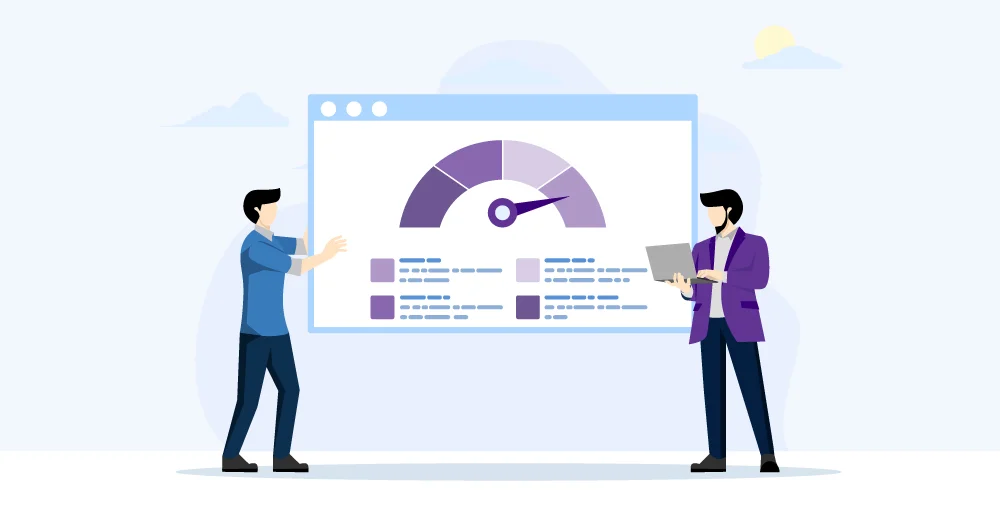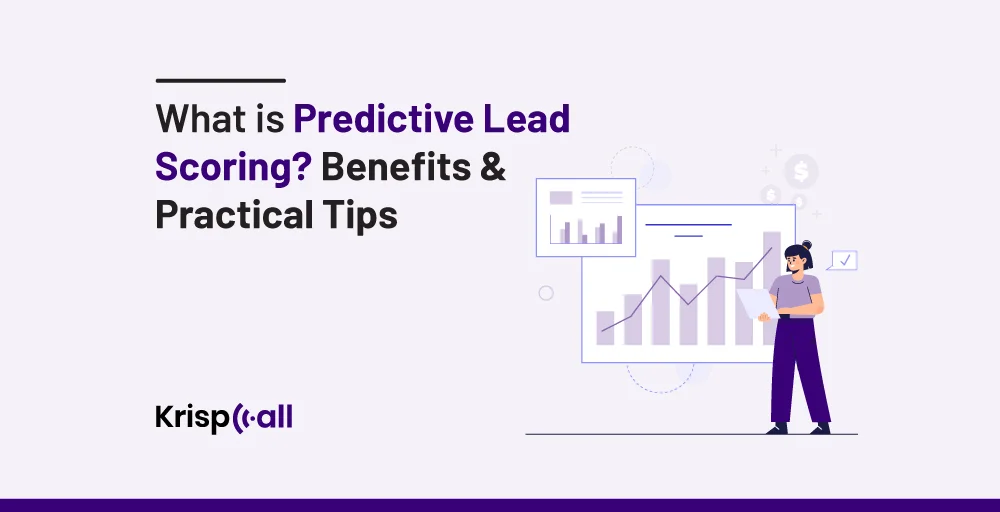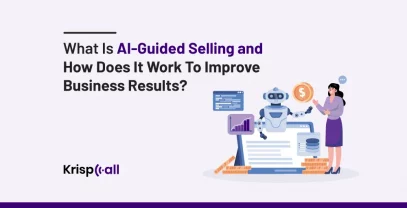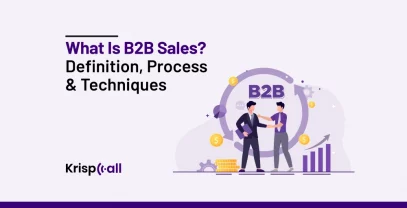Do your sales and marketing teams struggle to identify 🔎and prioritize leads worth pursuing?
Manually scoring leads is a time-consuming process that results in inconsistency in the quality of the lead generation method. Hence, you need software that generates leads automatically using data-driven insights and machine learning algorithms.
Predictive lead scoring is a solution for optimizing marketing and sales efforts to generate more leads that are most likely to convert. It enables team members to focus on promising prospects, personalize customer experiences, and improve conversion rates and lead management strategies.
😀 In this blog, we will discuss predictive lead scoring and how it benefits the business by generating more leads and driving more revenue. We will also cover practical tips on implementing the predictive lead-scoring method to enhance the sales pipeline.
🔑 KEY HIGHLIGHTS
- Predictive lead scoring is a modern, data-driven method for identifying the sales leads that are most likely to convert using customer historical and activity data.
- The key components of the predictive lead scoring method are CRM systems, predictive scoring software, call center software, data analytics, and contact lists.
- With predictive lead scoring, businesses can increase sales efficiency, save time and effort, create personalized engagements, and make data-driven decisions.
- To implement predictive lead scoring, you must purchase and integrate lead-scoring software, turn on predictive lead scoring in your CRM contact properties, and create workflows.
What is Predictive Lead Scoring?
Predictive lead scoring is a data-driven lead scoring method that uses historical data and machine learning algorithms to identify the sales leads that are most likely to convert. It uses historical activity data, predictive modeling, and statistical techniques to predict future behavior based on past behavior.

This approach enables businesses to manage leads more effectively, ensuring a smooth workflow by providing valuable insights into customer demographics, purchasing behaviors, preferred communication channels, and more. Doing so helps create an ideal customer profile and identifies the best ways to communicate with potential buyers.
Furthermore, predictive lead scoring aligns sales and marketing teams with data-driven lead qualification scores, leading to better prioritization of leads. This improves lead management and increases revenue by focusing efforts on those most likely to convert.
For example, if there are two leads in a pipeline, lead A and B. Lead A has a score of 80, and B has a 50 score. Based on the score, you can predict that lead A has a greater chance of converted into a potential customer. Later on, you can analyze lead B to gain insights into why it has a low score and identify how to improve it.
Predictive Lead Scoring Vs. Traditional Lead Scoring
Traditional and predictive lead scoring are different in their approach and effectiveness. Traditional lead scoring is based on manually predetermined assumptions and intuition. In contrast, predictive lead scoring is based on historical data and activity and uses machine learning algorithms and data analytics to predict the most likely convert leads.
Likewise, traditional lead scoring used explicit data such as demographic profiles, behavior patterns (website visits, email opens), and firmographics( business size and types). On the other hand, predictive lead scoring uses explicit and implicit data (behavioral patterns, social media interactions, and third-party data.
Traditional lead scoring may not adapt to changes and new data. It has limited scalability and flexibility due to predefined fixed assumptions and criteria. However, predictive lead scoring involves data analytics to analyze data and predict future behaviors and the ability to adapt to changes in data. It is a more stable and flexible method, and it learns from new data and adjusts the scoring model as needed.
How Does Predictive Lead Scoring Work?
Predictive lead scoring works by creating an ideal customer profile based on past purchasing behaviors and then matching current leads to this profile using relevant attributes. It uses machine learning and automation to identify quality leads and indicate their likelihood of conversion.
The predictive lead scoring method begins with collecting historical data from various sources, such as demographic profiles, website behavior, and customer interaction. It uses historical data to identify the different attributes of qualified leads and then implements a predictive lead-scoring modeling algorithm to analyze open leads.
After applying the model, the sales and marketing team prioritizes their efforts on the promising prospects. Then, the new leads are scored based on the conversion probability. Businesses can segment and personalize customer experiences using predictive lead scoring models to offer them a targeted experience.
Finally, a feedback loop is developed to monitor and refine the model’s performance. This is essential to ensure the effectiveness of predictive lead scoring and its adaptability to changing customer dynamics.
Benefits of Predictive Lead Scoring
Predictive lead scoring is an advanced lead scoring method that can be a powerful tool to generate quality leads and offers several positive benefits to the business.
Here are some of the benefits that predictive lead scoring offers:
1. Increased Sales Efficiency
The primary benefit of predictive lead scoring is that it helps increase sales efficiency by enabling sales teams to generate high-quality leads quickly. High-quality leads are more likely to convert into potential customers.
With automation and machine learning algorithms, predictive lead-scoring methods can help sales teams identify quality leads and transform them into possible customers.
2. Efficient and Time-saving
Compared to traditional lead scoring, predictive lead scoring is an efficient and time-saving method to predict potential customers. Predictive lead scoring automates the whole lead-scoring process.
Sales and marketing teams can spend less time analyzing leads and more time focusing on the ones most likely to become customers. This means higher conversion rates and delivering more value to those customers. With predictive lead scoring, teams can work smarter, not harder, to achieve their goals.
3. Better Alignment Between Sales and Marketing
Predictive lead scoring acts as a bridge and fulfills the gap between the sales and marketing teams. It enables both teams to set standardized and unbiased qualified leads. Such a better alignment between sales and marketing teams improves marketing efforts, which generate high-quality leads and ensure the sales team follows up on the most valuable prospects.
4. Personalized Engagement
You can create personalized customer engagement that matches the lead’s needs and preferences. When you have data on prospects’ buying decisions, you can offer personalized and targeted content and discounts to attract and convert them into customers. The personalized engagement has a higher chance of converting leads into potential buyers.
5. Data-Driven Decision Making
Predictive lead scoring doesn’t rely on guesswork and intuition; it depends on machine learning algorithms to identify the consumer’s needs and preferences. It makes decisions based on customer behavior and preferences. It gathers data from various sources, identifies areas for improvement, and helps optimize marketing and sales efforts.
6. More Accurate Predictions
Predictive lead scoring achieves more accurate predictions with advanced data analytics and machine learning algorithms lead-scoring method. It generates predictions based on demographics, behavior, preferences, and engagement metrics that improve lead quality. It eliminates human errors, bias, and guesswork and ensures sales and marketing efforts continuously focus on leads with higher conversion rates.
Key Components of Predictive Lead Scoring
Predictive lead scoring has the following key components:
CRM System
CRM (Customer Relationship Management) software is a primary part of predictive lead scoring because it is a data source. It provides data, such as prospects’ demographic profiles, preferences, and behaviors in the lead-scoring process. CRM systems include data analytics, contacts, and marketing campaigns.
Some of the popular CRM systems are HubSpot, Salesforce, and Pipedrive. They integrate with phone systems with multiple communication channels and track the whole process of how customers navigate the system. It provides the contacts lists when the lead-scoring algorithm determines a score.
Predictive Scoring Software or Algorithm
Predictive scoring software or algorithm is an AI-based model that uses machine learning techniques to examine historical data and track the lead’s conversion journey based on various factors. When marketing campaigns develop and convert high-quality leads, this algorithm consistently improves the model to score more potential customers using relevant attributes.
Predictive scoring can adapt and improve the scoring process over time, unlike traditional lead scoring methods, which depend on fixed rules. It considers a wide range of factors and patterns that human analysts might miss, resulting in more accurate predictions of lead quality.
Call Center Software
Cloud-based call center software is another vital component in predictive lead scoring. It offers multiple communication channels to optimize marketing campaign efforts. The contact center as a service (CCaaS) platforms provide communication channels such as SMS texting, self-service options, emails, VoIP phone services, social media, and omnichannel communication.
A contact center as a service (CCaaS) integrates with CRM systems and provides an agent dashboard with related customer data and sales scores. A high-paid version of such platforms also allows you to automate workflows and create predictive lead-scoring AI.
Data Analytics
Data analytics is essential to extract valuable insights from a large database through automation. Although it may not directly inform the predictive model scoring, it provides information about the lead’s preferred channels in a workflow.
Data analytics tracks and analyzes trends and helps to optimize the scoring model. Examining past performance, campaign data, and customer behavior patterns improves the accuracy of the lead-scoring algorithm.
Contact List
A contact list is also an essential component in predictive lead scoring; it consists of potential leads and prospects that have been collected through various channels. The contact list determines the effectiveness of the predictive lead scoring.
A CRM system stores contact details and information when people respond to marketing campaigns, tracks their history, segments the contact, and determines the ways to reach them. It is crucial for marketing and sales campaigns; it manages and segments all the company’s potential leads and customers.
How to Implement Predictive Lead Scoring?
There are several steps to implement predictive leading scoring effectively. Here’s a structured approach to implementing predictive lead scoring:
1. Purchase and Integrate Lead-Scoring Software
First, purchase the CRM platforms that offer a predictive lead-scoring model in their higher-tier plans. Most CRM providers sell predictive lead-scoring software as a separate add-on. After buying predictive lead scoring software, integrate it with the CRM system by following the guidelines.
2. Enable Predictive Lead Scoring in Your CRM Contact Properties
After integrating predictive lead-scoring software, first, navigate to your CRM systems’ Settings, then Properties and Contact Information; from here, you can enable your predictive lead-scoring software, which might be mentioned as Contact Priority, Likelihood to Close, or Predictive Lead Scoring.
3. Collect Lead Data
Once you have turned on predictive lead scoring, you must collect lead and customer data for the algorithm to analyze patterns in customer attributes. Generally, algorithms require 40-100 leads to analyze the patterns. You can collect the data from multiple channels through marketing and sales campaigns.
4. Create Workflows
A workflow is created after the algorithm collects enough data to identify the attributes for lead conversion. If the workflow is integrated with a CRM system, you can automate it in a CRM system or call center. For example, send an email to all leads who score above 50, add all leads to an autodialer campaign list who score above 70, and assign all leads for personalized follow-up who score above 90.
5. Evaluate and Compare Lead-Scoring Models
After implementing predictive lead scoring, it is essential to evaluate and compare it with a traditional lead scoring model to check the effectiveness of the transformation. Implementing predictive lead scoring must increase your lead conversation rate, lead conversion rate, and customer purchase rate.
Best Practices for Predictive Lead Scoring
Follow the following best practices for predictive lead scoring:
1. Select Your CRM System As Per Your Marketing Needs
Before choosing a CRM system, you must consider several factors, such as the expected number of contacts, budget, means of channels, workflow to implement, and the amount you will spend on predictive lead scoring software.
Choosing predictive lead scoring adds extra cost to what you pay for the CRM (Customer Relationship Management) system. A higher-tier CRM system is more expensive than a low-tier one. If your business only deals with a few thousand contacts at once, you can save money by selecting a low-tier CRM system that offers the marketing automation you need.
2. Integrate Predictive Lead Scoring Software with Call Center Automation and Workflows
Integrating predictive lead scoring software with call center automation and workflow provides valuable data insights into how leads are managed, optimized, and converted. This integration smooths the workflow by automating repetitive tasks.
To score leads, you can automate trigger marketing emails, auto-dialer lists, follow-up with SMS text, and sales-agent contact assignments. This helps agents’ efforts be more effective, and they can take advantage of CRM’s built-in functionality. This ensures consistent and quality lead generation and improves conversion rates.
3. Set Norms for Agents to Respond to Predictive Lead Scores
Setting norms for how agents respond to predictive lead scores is essential for optimizing sales. These norms guide agents on how to respond and how often they should follow up with leads according to their predictive score.
You can organize the lead-score response by segmenting the lead score into different tires with a particular response to each tire:
Example: Lead score response protocol (1-100)
- 80 or above: Move to the top of sales-agent priority for immediate contact.
- 60-80: Agents call after the higher-priority leads.
- 30-60: Send a marketing email.
- 15-30: Send a promotional email.
- 0-15: Send a nurturing email.
4. Regularly Monitor and Re-evaluate your Predictive Lead Scoring Model
You must ensure that your predictive lead-scoring model benefits your marketing strategy. You should regularly monitor and reevaluate it to optimize its effectiveness in generating more quality leads. To monitor the model, you should track metrics like lead conversion, sales closure, and purchase rates.
Regular monitoring and evaluation keep you updated with market trends, customer behavior, preferences, and competition changes. This helps your predictive lead-scoring model align with business goals and objectives and optimize the marketing and sales efforts.
Conclusion
Predictive lead scoring identifies sales leads with a higher chance of converting into customers. It relies on customer historical and activity data and uses machine learning algorithms and data analytics to predict quality leads. It also includes current trends, lead behaviors, and external factors that affect purchasing behaviors.
Predictive lead scoring helps businesses increase sales efficiency, save time and effort, align marketing and sales teams, create personalized engagements, help with data-driven decision-making, and provide more accurate predictions.





